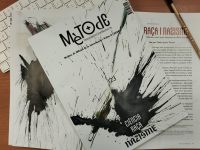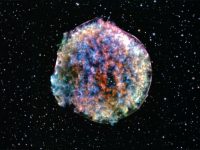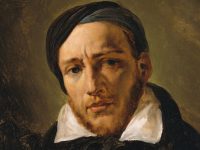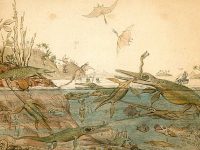Romantic travellers
The journeys of Alexander Von Humboldt and Charles Darwin
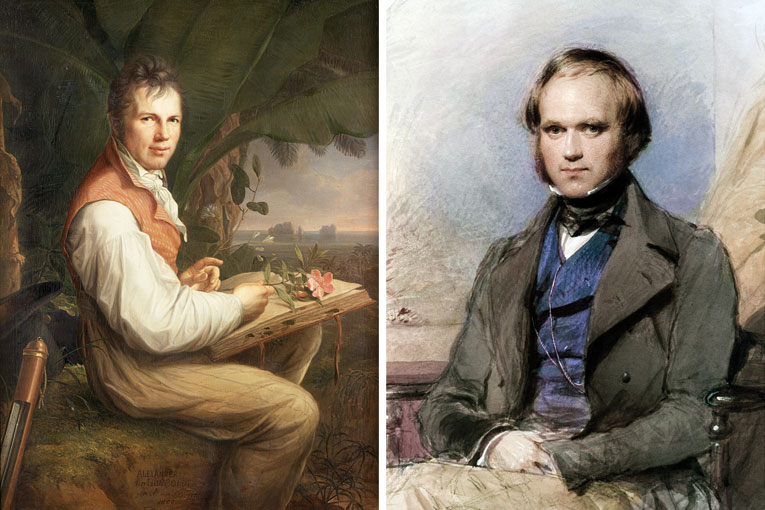
Humboldt and Darwin belonged to different generations and their approaches to the study of nature differed. However, they had something in common: their lives were shaken up and changed course after their respective journeys, which marked the starting point of their fruitful scientific careers.
Keywords: Alexander von Humboldt, Charles Darwin, scientific expeditions, nineteenth-century science.
In the late eighteenth century, the great colonial nations promoted journeys of discovery to improve cartography, search for raw material and collect natural and cultural exhibits for their museums: symbols of their power. Alexander von Humboldt (1769-1859) and Charles Darwin (1809-1882), two of the most famous naturalists in the history of science, both undertook a great journey of discovery, marking the starting point of their fruitful scientific careers. They belonged to a group of Romantic travellers who described exotic worlds where nature was still wild and mysterious, exalting the soul. However, there are many differences in the preparation, mission and results of these two amazing journeys.
The travellers before their journey
The mission of Romantic naturalists, with Humboldt at the helm (which is why we speak of «Humboldtian» science, is embedded in the recognition of the unity of nature. Thus, it endeavoured to discover and explore «how the forces of nature interreact upon one another and how the geographic environment influences plant and animal life». Since his first works on botany, geology or physiology he studied phenomena from all possible points of view, and cross-related all the data (Von Humboldt, 1860; Bowler and Morus, 2007; Fara, 2009).
«Humboldt and Darwin belonged to a group of Romantic travellers who described exotic worlds where nature was still wild and unknown and exalted the soul»
Humboldt’s passion for travel stirred very early, thanks to the influence of educators such as Joachim Heinrich Campe -writer and linguist, author of adventure stories- and his friendship with Georg Forster, naturalist on James Cook’s second voyage and also a travelogue writer (Puig-Samper Mulero and Rebok, 2007). In 1797 he decided to give up a promising administrative career to undertake a great journey which would lead him to formulate a general world theory for physics. Europe was fraught with war and thus his first plans were frustrated one by one. So after acquiring the precision instruments he believed necessary from the best craftsmen in Paris, the centre of the science at that time, he decided to travel to Spain in the company of Aimé Bonpland, intending to sail for Africa at the first opportunity. However, the intervention of the ambassadors of Saxony1 and the Netherlands and Minister Mariano de Urquijo, put him in contact with the Spanish Crown and provided the chance to undertake an unprecedented expedition to the Spanish colonies. Having obtained this permission, never before granted to anyone on such favourable terms, he was able to take any physical or astronomical measurement he wished with his instruments, and to collect samples of whatever he wanted. His only commitment was to send duplicates to the Spanish Crown, and to pay the costs (Puig-Samper Mulero and Rebok, 2007; Von Humboldt, 1826).
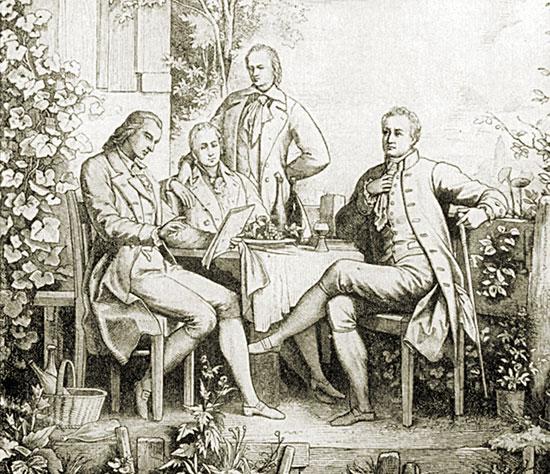
As Humboldt expressed in his report for the Crown, he wished to travel the world to see «the great harmonies of nature». The engraving shows the meeting of Schiller, Wilhelm and Alexander von Humboldt and Goethe in Jena in 1797. / Adolf Müller
Young Charles Darwin was enchanted by the story of Humboldt’s journey, published in 1814. Darwin was a good amateur geologist, who loved hunting and collecting insects, and had proven observational skills and a highly inquisitive mind; however, he was not much inclined to study nor was he too well trained in natural sciences. But as luck would have it, when he was just 23 years old in 1831, fate dealt him a future he could never have imagined (Darwin, 2008).
Darwin was planning a journey to Tenerife, set on seeing firsthand the magnificent landscapes of the Canary Islands and Mount Teide, which Humboldt had described so well. But Captain Robert Fitz-Roy, with depressive tendencies and an obsessive nature, was looking for a gentleman with whom to share polite conversation throughout the voyage of circumnavigation he was about to undertake. He was to set sail on a mission to chart the poorly mapped coasts in the southernmost tip of America and return three natives taken captive on a previous journey to Tierra del Fuego. Having been educated in England for a couple of years, these Fuegians were to help a missionary evangelize their peoples (Taylor, 2009).
«Humboldt globalized the world, breaking the Atlantic divide and creating a new one based on the equator»
With this object in mind, Fitz-Roy decided to bring a naturalist on board and, through a chain of acquaintances, his request ended up in the hands of John Henslow, Professor of Botany at Cambridge, who was well acquainted with young Darwin’s character and abilities. Upon receiving the proposal, and after overcoming his father’s objections with the help of his maternal uncle and future father-in-law, Josiah Wedgwood, he accepted the place, aware of the opportunities it provided in his career as a naturalist. An interview with Fitz-Roy confirmed there was a good rapport between them, despite the differences separating a staunch Tory, conservative and supporter of slavery, as Fitz-Roy was, from a liberal Whig and abolitionist, as was Darwin. Indeed, even Darwin’s nose, which Fitz-Roy -a follower of phrenology- considered improper for a person with strong determination, proved no obstacle because Darwin boarded the Beagle. That was, however, with his passage and expenses paid for by his father (Darwin, 2008; Moorehead, 1980; Taylor, 2009).
Humboldt’s journey
Humboldt and Bonpland sailed from La Coruña on June 5, 1799. Their journey would continue until August 1804 when they returned to France. On the journey, they visited the Canary Islands, and parts of what are nowadays Venezuela, Colombia, Ecuador, Peru, Mexico, Cuba and the United States. They explored the major river basins, like the Amazon, the Orinoco and the Negro, and studied the legendary volcanoes Chimborazo, Cotopaxi and Pichincha (Puig- Samper Mulero and Rebok, 2007). The travellers owed their safe-conduct to those responsible for the Spanish colonies, and always enjoyed maximum protection. Humboldt also received the collaboration of Spanish naturalists (Von Humboldt, 1826); indeed, his relationship with the great botanist José Celestino Mutis was excellent (Puig-Samper Mulero and Rebok, 2007).
«Humboldt’s narrative sparked the imagination of young Darwin, who proved to have keen observational skills and a highly inquisitive mind»
Humboldt stated in his writings to the Crown that he wished to travel the world not only to become acquainted with its species and its characteristics, but also to discover the influence of the atmosphere and chemical composition of organic bodies, the formation of the globe, the identity of geological layers in faraway countries, in short, to discover «the great harmonies in nature». The special collection of physical and astronomical instruments he acquired, some he himself designed, enabled him to determine the physical properties of nature. Pioneer in field work, he studied each site with great care. He astronomically determined longitude and latitude and the lie of the land with the help of a barometer, the magnetic declination and intensity, he collected plants at different levels and calculated the altitude at each point, as well as humidity, temperature, electrical charge and the degree of air transparency, he drew topographic maps and geologic profiles founded in part on the measure of vertical bases, and on angles of altitude. Moreover, to judge the accuracy of his results, he conserved details of all the partial measurements and operations; such was the utmost precision of his methodology (von Humboldt, 1826).
Making the journey overland gave him countless opportunities to study the properties of the most fertile parts of the country; however, it was much more arduous than travelling by boat and the difficulties of transporting materials were an additional drawback. Indeed, by the end of their journey, Humboldt and Bonpland were weighed down by dozens of boxes of books, as well as collections of plants, seeds, shells, insects and geological samples. This represented a convoy of 15 or 20 mules that had to be changed every 8 to 10 days, as well as the Indians needed to lead them. Part of the collection was sent to Europe but many specimens went missing along the way, often due to negligence, so Humboldt normally sent duplicates (Von Humboldt, 1826).
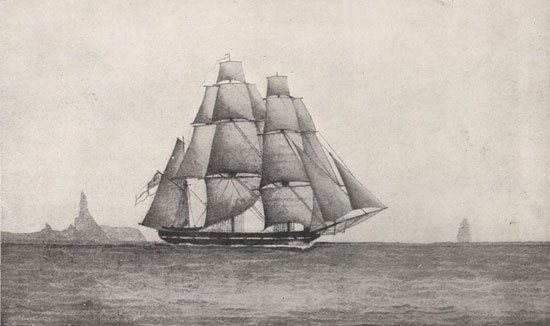
History has often revisited Darwin’s voyage on the Beagle. Darwin lived cheek by jowl with over seventy people on this little boat measuring just 90 feet in length, whose longest beam was barely over 20 feet. The Beagle sailed around the world from December 27, 1831 when it set sail from Plymouth until October 2, 1835 when reached Falmouth. / Cambridge University Library
Inspired by the German Romantic trend, Humboldt sought to understand the physical phenomena and their general connection and represent nature as a whole, driven by internal forces. His systematic collection of physical data of the globe would enable him to rationally infer the laws governing it. Humboldt «globalized» the world, breaking the Atlantic divide and creating a new one based on the equator. But in the Romantic mind, the way of seeing things was not exclusively scientific. Contemplation of nature in all its glory sparks wonderful feelings, mysterious inspiration stirred by the harmony of the laws governing natural forces. Humboldt believed in a deep communication between man and nature. Climbing the highest mountains and gazing down from the heights kindled this connection. His ascent, albeit incomplete, of the Chimborazo volcano in Ecuador was seen as a real achievement, a Romantic symbol and Humboldt was considered the man who had risen to the greatest heights of his time: a hero (Bowler and Morus, 2007; Fara, 2009).
Darwin’s journey
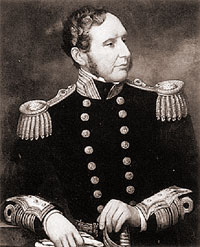
Captain Robert Fitz-Roy, with depressive tendencies and an obsessive nature, was looking for a gentleman with whom to share polite conversation throughout the voyage of circumnavigation he was about to undertake. A chain of acquaintances led him to ask Darwin, who accepted. / Royal Naval College, Greenwich
History has often revisited Darwin’s voyage on the Beagle. Darwin lived cheek by jowl with over seventy people on this little boat measuring just 90 feet in length, whose longest beam was barely over 20 feet. The Beagle sailed around the world from December 27, 1831 when it set sail from Plymouth until October 2, 1835 when reached Falmouth. The sea voyage was far from pleasant, and Darwin was seasick and spent a great deal of time in the small shared cabin he was assigned (Darwin 1959; Moorehead, 1980; Taylor, 2009).
His scientific mission was to collect samples (to be sent to England and classified), observe and read up as much as possible on natural history, and make observations on the weather. The scientific instruments taken on the expedition were those necessary for orientation, collection and recognition: compass, inclinometer, geological hammer, microscope, barometers, nets, flasks, and so on. In fact, the most accurate instruments carried by Captain Fitz-Roy were those for taking hydrographic and chronometric measurements (Taylor, 2009).
Darwin, young and inexperienced, was keen to learn, he was not endeavouring to establish a theory on the oneness of nature. He knew Lamarck’s theory and the evolutionary ideas entertained by his grandfather Erasmus, but at this point his stance was much closer to William Paley’s conservative natural theology. However, the five-year-long expedition was to turn him into a naturalist able to propose new models to explain the complexity of life. Some readings influenced him deeply: Humboldt’s narrative sparked his imagination and introduced him to a new methodology; the Preliminary discourse on the study of natural philosophy by John Herschel encouraged him to make his own contribution to science, and Charles Lyell’s Principles of Geology gave him a new perspective of Earth Sciences (Darwin, 2008).

For Darwin, the evidence of the huge gap between Native American Indians, whom he described as abject and miserable, and civilized man left a deep mark on his thoughts and his theory about the origin of mankind. Fitz-Roy’s portrayal of Indians. / Cambridge University Library
Darwin made long journeys inland, especially in South America where, emulating Humboldt, he studied the natural diversity. His diary A Naturalist’s Voyage Round the World, which he kept on Fitz-Roy’s advice, holds personal and accurate descriptions of the landscapes, species, people and nations. Some of the events that changed his way of interpreting natural phenomena were the wonderful diversity of the forest, the discovery of giant mammal fossils in Patagonia, the strange fauna endemic to the Galapagos Islands, the lethal effects of floods and droughts in the Pampas, the extraordinary geological formations on the costs of Tierra del Fuego, and the devastating effects of the earthquake he experienced Chile. Applying Lyell’s theory of gradual changes to what he saw in nature led Darwin to progressively abandon creationism and the theory of the flood and seek new solutions to explain the emergence and extinction of species, or geological phenomena such as the formation of atolls or coral islands. Other facts that struck Darwin concerned the cruelty of slavery, the brutality of war against the native peoples, corruption in the Spanish colonies and their meeting with tribes of Tierra del Fuego. He also reflected on the sad ending of Fitz-Roy’s anthropological experiment, when the three Indians – believed to be Christianized – tuned back to their savage ways once returned to their natural habitat. For Darwin, this evidence of the huge gap between those «creatures», which he defined as abject and miserable, and civilized man left a deep mark on his thoughts and his theory about the origin of mankind (Continenza, 2008; Darwin, 1983; Moorehead, 1980; Taylor, 2009).
Conclusion: After the journey
Humboldt and Darwin’s lives were shaken up and changed course after their respective journeys. They gained the respect of naturalists for the materials they gathered, including many new species, while the narrative of their adventures would bring them fame. Their biological, geological and paleontological discoveries would alter ideas on the natural sciences held at the time (Bowler and Morus, 2007).
Humboldt was to become the paradigm of scientific adventure, perhaps the last to master all fields of science in his time. A great diplomatic and cosmopolitan communicator, he was a faithful servant of his monarch and great colonial powers while also being sympathetic towards American revolutionary movements. He devoted twenty years of his life to classifying and publishing the data collected, helped by great scientists of his time, and also directed new expeditions. Humboldt’s work integrated the physical data with information on vegetation, landscape and society. He was a great visual innovator, and with the help of advances in technical publications he represented the data in a new way: cross-sectional drawing of mountains and diagrams of huge geographical areas based on statistical averages. His methodology and romantic style of narration inspired countless naturalists, including Darwin (Camós, 2005; Fara, 2009).
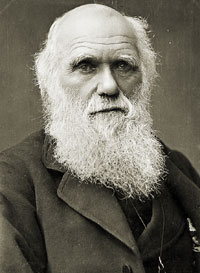
Darwin –taciturn, ill and confined to his country home– would always remain linked to natural selection. Both admired and ridiculed for placing man on the evolutionary ladder, he was to become a scientific myth in the twenty and twenty-first centuries. / Herbert Rose Barraud, 1881
When Darwin reached England in 1835, his reputation preceded him, already a respected person in the scientific arena. The success of his journey was to be popularized through the book The Zoology of the Voyage of H.M.S. Beagle, in which leading British experts analyzed the materials collected, and Darwin gave a personal account of his story and his works on geology. In these early years he was welcomed to form part of the British scientific community and was appointed secretary of two scientific societies. It was during this period that he began to develop what he called «his theory». Then in 1842, three years after having married his cousin Emma and in a precarious state of health that would dog him for the rest of his days, he withdrew to a house in Down, some 20 miles from London, and began his most thorough and renowned scientific work: an exhaustive study on the classification of barnacles (Bowler and Morus, 2007; Continenza, 2008; Darwin, 2008).
In 1859, on learning that Alfred Russell Wallace had reached similar conclusions to his own, and encouraged by his colleagues, Darwin published On the Origin of Species igniting new evolutionary views that would pervade all branches of knowledge. The same year was to witness Humboldt’s death. This illustrious Prussian figure, the most famous scientist of the nineteenth century, would slowly fade. Indeed, his theory of synthesis, based on infinite data and forming a colossal work, almost fell into oblivion in the late nineteenth century due to scientific and political upheaval. Darwin, meanwhile, taciturn, ill and confined to his country home, would always remain linked to natural selection. Admired and ridiculed alike for placing man on the evolutionary ladder, he was to become a scientific myth in the twenty and twenty-first centuries.
Notes
1. The ambassador of Saxony, Baron von Forell (1756-1808) was well versed in mineralogy and ran a geognostic office. (Go back)
References
Bowler, P. J. and I. R. Morus, 2007. Panorama general de la ciencia moderna. Crítica. Barcelona.
Camós, A., 2005. «Humboldt en algunos medios de comunicación en el siglo xix en España». In Cremades, J; Dosil, F. J. and X. A. Fraga (eds.), 2005. Humboldt y la ciencia española. Ediciós do Castro. La Coruña.
Continenza, B., 2008. «Darwin». Temas Investigación y Ciencia, 54.
Darwin, Ch., 1983. El viaje del Beagle. 2 volums. Labor. Barcelona.
Darwin, Ch., 2008. Autobiografia. Monografies Mètode. Valencia.
Fara, P., 2009. Breve historia de la ciencia. Ariel. Barcelona.
Moorehead, A., 1980. Darwin. La expedición en el Beagle. Serbal. Barcelona.
Puig-Samper Molero, M. A. and S. Rebok, 2007. Sentir y medir. Alexander von Humboldt en España. Doce calles. Aranjuez.
Taylor, J., 2009. El viaje del Beagle. Planeta. Barcelona.
Von Humboldt, A., 1826. Viaje a las regiones equinocciales del nuevo continente. Casa de Rosa. Paris.
Von Humboldt, A., 1860. Cosmos. Harper and brothers. New York.


